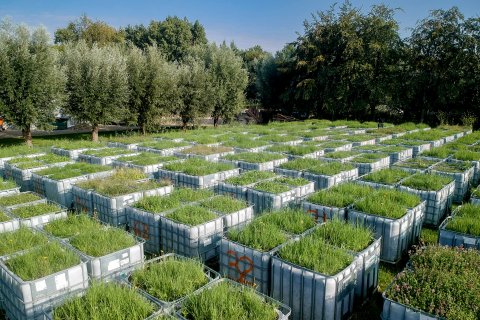BioCliVE
In hundreds of containers behind the greenhouses at the BotanicGardens, Utrecht plant- and soil ecologists are replicating natural grasslands to study the effect that a changing climate and the loss of biodiversity have on the ecosystem. The Utrecht University Biodiversity and Climate Variability Experiment (UU BioCliVE) is unique in its scale and time frame.

Thirty percent of the Netherlands surface area consists of grassland. As the climate changes, these and other landscapes will have to deal with more frequent extreme weather events in the future, such as long summer droughts and floods due to heavy rainfall. At the same time, biodiversity is rapidly decreasing around the world, grassland species are disappearing from the Dutch landscape due to excessive nitrogen levels, water drainage, and habitat fragmentation.

This development is problematic, because scientists expect the areas with high levels of biodiversity to be better able to deal with these extreme weather conditions. “That’s because the wide range of different species in more diverse ecosystems will always have one or more species that can thrive under more extreme conditions”, explains ecologist George Kowalchuk.

352 containers
In this large-scale, long-term experiment, the researchers will test that hypothesis by experimenting with the combination of climate change and loss of biodiversity. Behind the greenhouses at the Botanic Gardens, they have installed 352 containers that each hold around 1,000 litres of soil material taken from natural river grasslands. Each of these containers has a different level of biodiversity: some contain 1 or 4 plant species, while others hold 8 to 12. These miniature grasslands will then be exposed to different climate regimes: some will face wetter winters and drier summers, while others will be inflicted with extreme weather, a shift from the current precipitation pattern, or a combination of both. “In doing so, the researchers hope to be able to determine the extent to which grassland biodiversity will be able to deal with the negative effects of future extreme weather conditions, and how much of the grasslands’ buffer capacity is reduced through the loss of biodiversity”, says Kowalchuk.
Futureproof grasslands
With this research structure, BioCliVE will lay the foundation for the grassland of the future. The project is unique in its scale and in the duration of the study. The researchers are planning on following the miniature grasslands for 15 years in order to identify the long-term effects. The containers were installed in 2017, and after allowing the grassland to develop and flourish for a few years, they will be exposed to different climate regimes starting in 2020. The knowledge that the researchers gain in the process can then be used to create more future-proof grasslands that are better able to adapt to drought, heavy precipitation, and wide fluctuations between the two.
BioCliVE is a collaborative project by the plant- and soil ecologists from the Ecology & Biodiversity group at Utrecht University: Yann Hautier, Mariet Hefting, George Kowalchuk, Edwin Pos, Merel Soons & Marijke van Kuijk.

